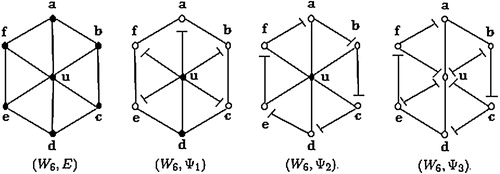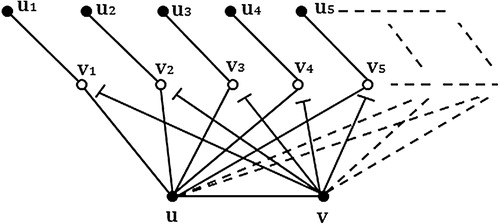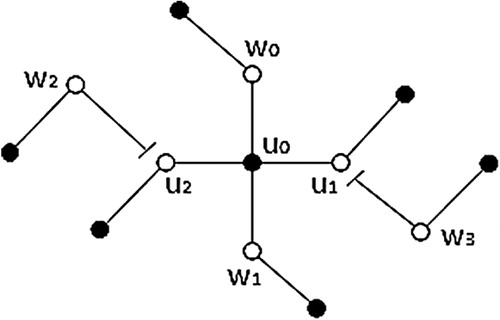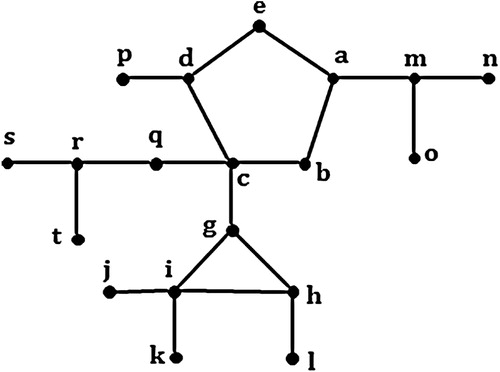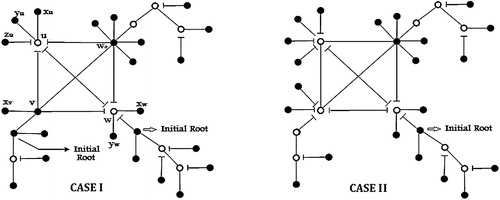 ?Mathematical formulae have been encoded as MathML and are displayed in this HTML version using MathJax in order to improve their display. Uncheck the box to turn MathJax off. This feature requires Javascript. Click on a formula to zoom.
?Mathematical formulae have been encoded as MathML and are displayed in this HTML version using MathJax in order to improve their display. Uncheck the box to turn MathJax off. This feature requires Javascript. Click on a formula to zoom.Abstract
Given a graph , not necessarily finite, a graphoidal cover of
means a collection
of non-trivial paths in
called
-edges, which are not necessarily open (not necessarily finite), such that every vertex of
is an internal vertex of at most one path in
and every edge of G is in exactly one path in
. The set of all graphoidal covers of a graph
is denoted by
and for a given
the ordered pair
is called a graphoidally covered graph.
Two vertices and
of
are
-adjacent if they are the ends of an open
-edge. A set
of vertices in
is
-independent if no two vertices in
are
-adjacent and is said to be
-dominating if every vertex of
is either in
or is
-adjacent to a vertex in
;
is
-definable (
-definable) if
has a finite
-dominating (
-independent
-dominating) set. Clearly, if
is
-definable, then
is
-definable and
. Further if for any graphoidal cover
of
such that
then we call
as a least-kernel graphoidal cover of
(in short, an LKG cover of
). A graph is said to be a least kernel graphoidal graph or simply an LKG graph if it possesses an LKG cover.
This paper is based on a conjecture by Dr. B.D Acharya, “Every graph possesses an LKG cover”. After finding an example of a graph which does not possess an LKG cover, we obtain a necessary condition in the form of forbidden subgraph for a graph to be a least kernel graphoidal graph. We further prove that the condition is sufficient for a block graph with a unique nontrivial block. Thereafter we identify certain classes of graphs in which every graph possesses an LKG cover. Moreover, following our surmise that every graph with possesses an LKG cover, we were able to show that every finite graph with
is indeed an LKG graph.
1 Introduction
Throughout this paper we consider simple graphs without loops as treated in most of the standard text-books on graph theory such as [Citation1]. For terminologies used in this paper without defining explicitly we refer to [Citation2]. Further, unless mentioned otherwise, graphs will be assumed to be connected and infinite.
The concept of graphoidal covers [Citation3] was first introduced by Acharya and Sampathkumar in 1987 as a close variant of another emerging discrete structure called semigraphs [Citation4]. Many interesting notions like graphoidal covering number [Citation3], graphoidal labeling [Citation5], graphoidal signed graphs [Citation6], etc. were introduced and are being studied extensively. In particular, notion of graphoidal covering number of a graph has attracted many researchers and numerous work is present in literature [7–11Citation[7]Citation[8]Citation[9]Citation[10]Citation[11]]. Acharya and Gupta in 1999 extended the concept of graphoidal covers to infinite graphs and introduced notion of domination in graphoidally covered graphs [Citation2,Citation12,Citation13]. A detailed treatment of graphoidal covers and graphoidally covered graphs is given in [Citation2,Citation14].
In this paper we continue our work in [Citation15] and hence extend the work on domination in graphoidally covered graph [Citation2,Citation12,Citation13]. A graphoidally covered graph consists of a graph
and a collection
of nontrivial paths in
, which are not necessarily open (not necessarily finite), such that
| [G1] | = | every vertex of |
| [G2] | = | every edge of |
The set is called a graphoidal cover of the graph
and a member of
is called a
-edge. The set of all graphoidal covers of
is denoted by
.
It may be noted that a -edge could possibly be infinite; in particular, it may be a one-way infinite path (or, the often so-called ‘ray’) or a two-way infinite path. Further, a finite open
-edge has two distinct end vertices and a closed
-edge has only one end vertex, which is specified by
. Next, a one-way infinite
-edge has exactly one end vertex while a two-way infinite
-edge has no end vertex. Moreover three types of vertices may exist in a graphoidally covered graph
viz. exterior vertex or a black vertex (vertex which is not an internal vertex of any
-edge), interior vertex or a white vertex (vertex which is not an end-vertex of any
-edge) and composite vertex (vertex which is neither an exterior vertex nor an interior vertex). In the diagrammatic representation, black vertex is shown as a small filled circle, white vertex is shown as a small unfilled circle and a composite vertex is represented as an unfilled circle with as many small tangents to the circle as the number of
-edges for which this vertex is the end-vertex and each tangent indicates an end-vertex of the corresponding
-edge.
In we give diagrammatic representation of four different graphoidal covers, namely, and
of wheel
, where
is the edge set of
,
Clearly, and hence we call
, the edge set of
, the trivial graphoidal cover of
; a graphoidal cover that is not trivial will be referred to as being nontrivial. Two distinct vertices
and
of
are
-adjacent if they are the ends of an open
-edge; a vertex is said to be self
-adjacent if it is both the ‘initial’ and the ‘terminal’ end of a closed
-edge (i.e., a cycle in
) — in either case, we represent the fact by writing
. The
-degree
of a vertex
is then defined as the number of
-edges having
as their end-vertex. A vertex is said to be a
-pendant vertex if its
-degree is one and a vertex is said to be a
-support if it is
-adjacent to at least one
-pendant vertex.
A theoretical motivation to study graphoidally covered graphs is that every ear-decomposition of a finite -connected (
-edge connected) graph
(cf.: [Citation1], p.146) is a graphoidal cover of
, but not conversely; thus, the notion of a graphoidal cover of any graph can be looked upon as a generalization of the notion of an ear-decomposition.
A set of vertices in a graphoidally covered graph
is a
-dominating set (or ‘
-domset’ for short) if every vertex of
is either in
or is
-adjacent to a vertex in
; if
contains a finite
-dominating set, then the least cardinality of such a set is denoted by
and is called the
-domination number of
; such graphs are called
-definable.
A set of vertices in a graphoidally covered graph
is a
-independent set if no pair of distinct vertices in
are
-adjacent and a
-dominating set
, which is also
-independent is called a
-kernel. If
contains a finite
-kernel then the least cardinality of a
-kernel of
is denoted by
and then
is said to be ‘
-definable’. In case
is
- (
-) definable then it is often convenient to call a
-dominating set (
-kernel) consisting of
(
) vertices a
-set (
-set). Clearly, if
is
-definable then it is
-definable, but the converse may not be true for infinite graphs. In , we have an infinite graph
and a graphoidal cover
of
such that
is
-definable but not
-definable. However, if
is an infinite claw free graph, then for the trivial graphoidal cover
,
-definability implies
-definability and in that case
. This fact can be proved using the technique used in the proof of Allan–Laskar Theorem [Citation16] on claw free graphs.
Theorem 1.1
If is a
-definable infinite claw free graph, then
is
-definable and
.
For we denote
and call it the domination number of
, and denote
, and call it the independent domination number of
, subject to the existence of these parameters, well in compatibility with these notations in the theory of domination in the case of finite graphs (e.g., see [17–19Citation[17]Citation[18]Citation[19]]).
2 Least kernel graphoidal graphs
A graphoidal cover of graph
is such that
is
-definable then
(2.1)
(2.1) For the trivial graphoidal cover
, the above inequality reduces to
We call a graphoidal cover
to be a least kernel graphoidal cover (or simply an LKG cover) of
if
is
-definable and
(2.2)
(2.2) A graph
is said to be a least kernel graphoidal graph (or simply, LKG graph) if
possesses an LKG cover.
For , this reduces to the well known equality
first considered by Allan–Laskar. By Allan Laskar Theorem [Citation16], for every finite claw free graph
. Also, for every
-definable infinite claw free graph
. Therefore the trivial graphoidal cover of every finite claw free graph and every
-definable infinite claw free graph is an LKG cover.
Following are some of the basic but important observations which arise from the definition of graphoidal cover and an LKG cover.
Lemma 2.1
[Citation15]
Every pendant vertex of a graph is a
-pendant vertex, for each
.
Lemma 2.2
[Citation15]
If is a support to
pendant vertices, then for each
, at least
of these pendant vertices are
-pendant vertices, with
as their common
-support.
Lemma 2.3
[Citation15]
Let be such that
is
-definable and if
is a
-support to more than one
-pendant vertices, then every
-set of
contains
.
Lemma 2.4
[Citation15]
If is an LKG cover of
and
are such that
, then at most one of
and
can be a
-support to more than one
-pendant vertex.
The contents of this paper are based on a conjecture by Dr. B.D Acharya “Does every graph possess a least kernel graphoidal cover ?” In [Citation15], it is proved that the graph (see ) obtained by adjoining
new vertices of degree one at each vertex of complete graph
is not an LKG graph. Thus not every graph is an LKG graph. Hence it becomes interesting to find those graphs which possesses an LKG cover.
Before going into the exploration of LKG graphs, we shall first show that any graph having as its subgraph such that pendant vertices of
are pendant vertices in the graph is not an LKG graph.
Theorem 2.5
If is a graph having
as its subgraph such that pendant vertices of
are pendant vertices in
. Then
is not an LKG graph.
Proof
Let be any graphoidal cover of
. If
is not
-definable, then by definition,
cannot be an LKG cover. Let
be such that
is
-definable. We shall prove that
is not an LKG cover. In view of Lemma 2.4, it is enough to show that there exists a pair of
-adjacent vertices in
such that each is
-support to two
-pendant vertices. Further, since every vertex in
is a support to
pendants, by Lemma 2.2, every vertex in
is
-adjacent to at least two
-pendant vertices. Hence it suffices to show that there exists a pair of
-adjacent vertices in
i.e., there exists an open
-edge
in
having both its end vertex in
.
Suppose on the contrary, graphoidal cover be such that for each
, either
is closed or at most one end vertex of
lies on
. Let
and
be a
-edge such that
contains maximum number of edges of
i.e.,
for all
. Then by definition of graphoidal cover,
and thus we have four possibilities:
Case 1. .
Then is a cycle of length
and in that case one of the diagonal of the cycle must be a
-edge, a contradiction to the assumption that at most one end vertex of an open
-edge lies on
.
Case 2. .
If , then as
contains three edges of
, at least three vertices say
of
are internal vertices of
. Hence one of the edges
must be a
-edge, contradiction. Thus
and consequently,
must be a cycle of length
. Without loss of generality, assume that
. Let
be the
-edge containing the edge
. Clearly,
. Since
is an internal vertex of
, it is an end vertex of
and hence
is an internal vertex of
. Also,
does not lie on
(for if,
contains
, then
, a contradiction). But then
is a
-edge, again a contradiction.
Case 3. .
If , then
is an open path of length
having both its end vertices in
, a contradiction. Hence
and consequently, at least two vertices in
are internal vertices of
. Without loss of generality, assume that
are internal vertices of
. If
, then
is a
-edge, contradiction. Hence
. Again without loss of generality, assume that
. Let
be the
-edge containing the edge
. Then
is an end vertex of
,
is an internal vertex of
and
does not lie on
. But then
is a
-edge, contradiction.
Case 4. .
Then by maximality of , any
-edge can contain at most one edge of
. Let
,
and
be the
-edges containing the edges
,
and
respectively. Since
can be an internal vertex to at most one
-edge, with no loss of generality, we assume that
is an end vertex of
and
. But then
and
are internal vertices of
and
respectively and therefore
must be a
-edge, a contradiction.
Thus in all the cases we arrived at a contradiction. Hence our assumption is wrong and there exists a pair of -adjacent vertices in
. Thus
is not an LKG cover. Since
is arbitrary, we conclude that
does not possess any LKG cover. Hence
is not an LKG graph. □
Thus Theorem 2.5 provides us with a necessary condition in the form of forbidden subgraph for a graph to be an LKG graph. Our hunch is that the condition of Theorem 2.5 is sufficient as well for a graph to be an LKG graph. In fact we shall prove that the condition is indeed sufficient in case of separable graphs with unique non-trivial block isomorphic to for some
.
Before that we need to discuss an important technique of decomposing trees into spiders which is used in [Citation15] to obtain an LKG cover for any given tree. By spider we mean a tree homeomorphic to star
for some positive integer
. The center of
is called the root, and the paths having the root as one of their ends and the other ends being the pendant vertices of
being called legs of the spider.
Algorithm
Spider Decomposition of a Tree 

Set ,
and
.
| STEP 1. | = | Choose any vertex |
| STEP 2. | = | Set |
| STEP 3. | = | Set |
| STEP 4. | = | IF |
Suppose this process terminates after repeating times, then we obtain a sequence of maximal spiders
in such a way that (i) the root
of the
th spider
lies on a leg of any one of the spiders
, (ii)
, and (iii)
for all
.
Let consist of all the legs of all the spiders
and
be the set consisting of all the roots
and all the vertices of degree at least
of
. Then it was proved in [Citation15] that
is an LKG cover of
with
as a
(
)-set (see ).
Theorem 2.6
[Citation15]
Every finite tree admits a least-kernel graphoidal cover.
The technique of spider decomposition can be easily extended to show that every cactus possess an LKG cover.
Lemma 2.7
Let be a unicyclic graph with unique cycle
and
. There exists an LKG cover
of
with
as one of its black vertices.
Proof
Let and
be non-trivial components of the forest
. For each
, let
. Let
be an LKG cover of
obtained by spider decomposition technique taking
as the initial root and
be the corresponding
(
)-set. Consider the collection
where
is a closed path in
with
as coincident end vertex. Then
is a graphoidal of
with
as one of its black vertex and the set
is a
-set of
. Therefore
of
is an LKG cover of
and
is an LKG graph. □
Thus given any vertex of the cycle in the unicyclic graph, we can always construct an LKG cover with that vertex as one of the black vertex. This observation helps us in constructing an LKG cover for any given cactus. The concept of free paths in a graph will also be used while constructing an LKG cover for a cactus. A free path [Citation2] in a graph is a maximal path each edge of which is a bridge in
. The set of all free paths of
is denoted by
. The set of all free paths of the cactus
in is given by
Theorem 2.8
Every finite cactus admits a least kernel graphoidal cover.
Proof
Let be a cactus having
nontrivial blocks.
Claim
Corresponding to any vertex of any non-trivial block
of
, there exists an LKG cover of
with
as one of its black vertex.
We will prove the claim by induction on . If
, then
is a unicyclic graph, whence by Lemma 2.7 we have the existence of the required LKG cover of
. Suppose the claim is true for
. We now prove it for
. Let
be any nontrivial block of
and
be any vertex of
. Let
and
Then
is a unicyclic graph and therefore by Lemma 2.7 there exists an LKG cover
of
with
as one of its black vertex.
Let be the graph obtained from
by removing all the isolate vertices and
be the components of
. For each
, let
. Since each
has at most
nontrivial blocks, by induction hypothesis there exists an LKG cover
of
such that
is a black vertex of
. Then clearly,
is an LKG cover of
with
as one of its black vertex. Hence the proof of the claim follows by induction. □
Next following our hunch that every graph with admits an LKG cover, we were able to prove that every graph with
is indeed an LKG graph using a well known fact that a
-connected graph has an ear decomposition (cf. [Citation1], p.146).
Theorem 2.9
Every finite graph with
admits an LKG cover.
Proof
We will prove this theorem in two cases:
CASE 1. is a nonseparable (2-connected) graph.
has an ear decomposition and therefore
can be partitioned into
such that
is a cycle and
for
is a path addition to the graph formed by
. We claim that the graphoidal cover
of
is an LKG cover. For each
, let
be end vertices of the
-edge
. Then the set
is a
-set of
. Hence
admits an LKG cover.
CASE 2. is a separable graph.
Let be non-trivial blocks of
. For each
, the block
is 2-connected and hence as in Case 1, using ear decomposition of
, we obtain an LKG cover
of
with
as a
-set of
.
Let be the forest obtained from
by removing all isolates. Let
be the components of
. Then for each
, the spider decomposition of
provides us an LKG cover
of
with a
-set
. Let
where
. Since
, the collection
forms an LKG cover of
with
as
-set. Thus
admits an LKG cover. □
Further following our surmise that the condition in Theorem 2.5 is sufficient also for a graph to be an LKG graph, we were able to prove that it is indeed sufficient for separable graphs with a unique non-trivial block isomorphic to for some
.
Theorem 2.10
Let be a finite separable graph with a unique non-trivial block
for some
. Then
is an LKG graph if and only if at most three vertices of
are support to more than three pendant vertices in
.
Proof
Necessity follows from Theorem 2.5.
Conversely, Suppose has a unique non-trivial block (say)
such that at most three vertices of
could support more than three pendant vertices. Let
be a partition of
, where
For each
, let the three pendant vertices with
as their support be denoted by
and
. For each
, let
denote the pendant vertices with
as their support. For each
, let
be the unique pendant vertex with support
.
By hypothesis, , therefore we have two possibilities:
Case 1.
Let be a vertex in
supporting maximum number of pendant vertices (in case there is no support in
, then we can take
to be any vertex of
). Let
be the forest obtained from
by deleting all the isolate vertices. Let
be the components of
. For each
, let
. By using spider decomposition technique keeping
as the initial root, we get an LKG cover
of
and a
-set
.
Let and
. Let
denote the set consisting of all edges in
which are neither covered by
nor by
. Then
is an LKG cover of
with
-set (
-set)
where,
Case 2.
Choose any cycle in
of length
such that
. Consider the forest
obtained from
by removing all the edges of the cycle and the resulting isolates. Let
be components of
. Now for each
, let
. Then with spider decomposition technique construct an LKG cover
of tree
with
as the initial root. Let
be the
-set obtained during the process.
Let and
. Let
denote the set consisting of all edges in
which are neither covered by
nor by
. Then
is an LKG cover of
with
-set (
-set)
where,
Thus in either case there exists an LKG cover of and hence
is an LKG graph (see ). □
3 Concluding remarks
In [Citation2], Acharya and Gupta introduced the concept of domination to graphoidally covered graphs. In [Citation15], based on the fundamental problem of determining the graphs in which domination number equals the independent domination number, the concept of least kernel graphoidal graphs (LKG graphs) was introduced. In this paper, extending the work in [Citation15], we found a necessary condition for a graph to be an LKG graph. Also, we have not found any graph which does not possess LKG cover and satisfies the condition of Theorem 2.5. Hence we conjecture
Conjecture 1
A graph is an LKG graph if and only if
is not having
as its subgraph such that pendant vertices of
are pendant vertices in
.
We showed that due to Allan Laskar Theorem, the trivial graphoidal cover of every claw-free is an LKG cover and hence every claw free is an LKG graph. But then one may be tempted to ask does every claw free graph possess a non-trivial LKG cover? Also, one may look for graphs in which every graphoidal cover is an LKG cover. Further, all these problems can be seen in terms of acyclic graphoidal covers of a graph.
If is a graph having a graphoidal cover
such that
, then
is an LKG cover of
and consequently,
is an LKG graph. Also, a graph
which possesses a graphoidal cover
such that
is the only
-dominating set of
is trivially an LKG graph with
being one of its LKG cover. B.D Acharya, et al. in [Citation12,Citation13], have obtained characterization for such graphs.
Notes
Peer review under responsibility of Kalasalingam University.
References
- West Douglas B. Introduction to Graph Theory 1996 Prentice Hall, Inc. Upper Saddle River, NJ xvi+512
- Devadas Acharya B. Gupta Purnima Domination in graphoidal covers of a graph Discrete Math. 206 1–3 1999 3 33 Combinatorics and number theory (Tiruchirappalli, 1996)
- Devadas Acharya B. Sampathkumar E. Graphoidal covers and graphoidal covering number of a graph Indian J. Pure. Appl. Math. 18 10 1987 882 890
- E. Sampathkumar, Semigraphs and their applications, Report on the DST Project, 2000.
- Sahul Hamid I. Anitha A. On label graphoidal covering number—I Trans. Combin. 1 4 2012 25 33
- Siva Kota Reddy P. Misra U.K. Graphoidal signed graphs Proc. Jangjeon Math. Soc. 17 1 2014 41 50
- Pakkiam C. Arumugam S. On the graphoidal covering number of a graph Indian J. Pure. Appl. Math. 20 4 1989 330 333
- Arumugam S. Suresh Suseela J. Acyclic graphoidal covers and path partitions in a graph Discrete Math. 190 1–3 1998 67 77
- Arumugam S. Rajasingh I. Pushpam P.R.L. Graphs whose acyclic graphoidal covering number is one less than its maximum degree Discrete Math. 240 1–3 2001 231 237
- Arumugam S. Pakkiam C. Graphs with unique minimum graphoidal cover Indian J. Pure. Appl. Math. 25 11 1994 1147 1153
- Arumugam S. Pakkiam C. Graphoidal bipartite graphs Graphs Combin. 10 4 1994 305 310
- Acharya B.D. Gupta Purnima Further results on domination in graphoidally covered graphs AKCE Int. J. Graphs Comb. 4 2 2007 127 138
- Acharya B.D. Gupta Purnima Jain Deepti On graphs whose graphoidal domination number is one AKCE Int. J. Graphs Comb. 12 2–3 2015 133 140
- Arumugam S. Devadas Acharya B. Sampathkumar E. Graphoidal covers of a graph: a creative review Graph Theory and Its Applications (Tirunelveli, 1996) (1997) Tata McGraw-Hill. New Delhi. 1–28.
- Gupta Purnima Singh Rajesh Domination in graphoidally covered graphs: Least-kernel graphoidal covers Electron. Notes Discrete Math. 53C 2016 433 444
- Allan Robert B. Laskar Renu On domination and independent domination numbers of a graph Discrete Math. 23 2 1978 73 76
- Haynes Teresa W. Hedetniemi Stephen T. Slater Peter J. Fundamentals of domination in graphs Monographs and Textbooks in Pure and Applied Mathematics vol. 208 (1998) Marcel Dekker, Inc.. New York. xii+446.
- Hedetniemi S.T. Laskar R.C. Bibliography on domination in graphs and some basic definitions of domination parameters Discrete Math. 86 1–3 1990 257 277
- Haynes Teresa W. Hedetniemi Stephen T. Slater Peter J. Domination in Graphs Monographs and Textbooks in Pure and Applied Mathematics vol. 209 (1998) Marcel Dekker, Inc.. New York. xiv+497. Advanced topics

